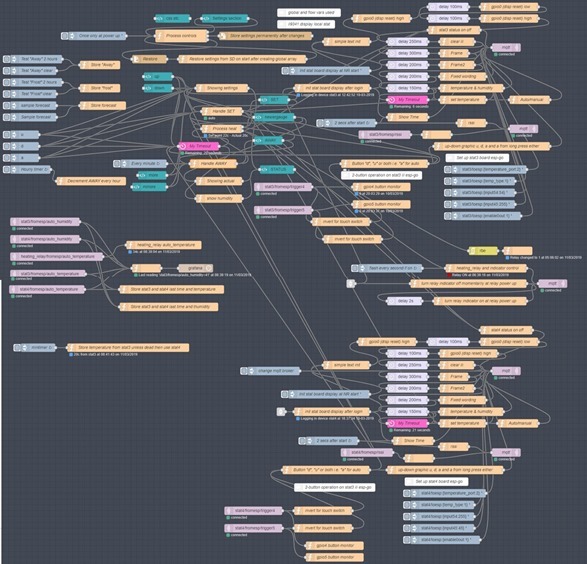I’m too deeply buried in R&D right now to fully develop another article on my thermostat but here is some info to add to the previous blog entry on the subject. The Node-Red/ESP-GO thermostat is now in operation, awaiting a front panel from Aidan (in the post apparently but he’s off on holiday).
Meanwhile I’ve yet to publish updates to ESP-GO-3 – on test – and using Espressif Non-OS SDK 3.1 – which in itself is still only on GIT at the time of writing. My thanks to helpers on the Espressif forum – I didn’t absolutely need this for the thermostat project but the 5K of saved iRAM gives me bags of room for expansion so now was as good a time as any.
Some visuals – here is my Grafana logging – accessible externally thanks to PIVPN as is the stat.
Above is my Grafana info screen – monitoring and logging the two stats (main and aux) and also temperature in the hot water tank cupboard from the mains controller supplying on-off instructions to the air—source heating system.
Lots more below the line…
The main (green) sensor is currently at 20c (air source takes ages to reach full set temperature) and that is the sensor in use (aux in yellow is a fall-back). Humidity is for reference only – ultimately I’ll factor that into the heat. It generally FEELS a little warmer when the air is dry. Here is the stat as it appears online (only via PIVPN, deliberately).
Final colours will be more subtle – recommendations? And yes, the temperature does need to rise quite early in the morning – on really cold mornings there is a lot of lag before radiators get up to full temperature. As you can see, the Nod-Red flow is getting way too big for one screen. Most likely now unreadable even on expanding but hopefully it will give you some idea.
The actual physical stats still look like a dog’s breakfast due to lack of casing. Below, stat4 on test minus it’s up-down buttons on my bench, working on USB and with it’s plastic screen protector still in place. Stat3 is boxed, running on its own internal mains power supply and in the house, getting the spouse-test. 2 days without issues.
These stats are deliberately simplified allowing limited up-down temporary temperature change and monitoring of local temperature and humidity as well as SET temperature monitoring and heating status with WIFI signal RSSI thrown in for good measure.
The post The Thermostat Continues appeared first on Scargill’s Tech Blog.








